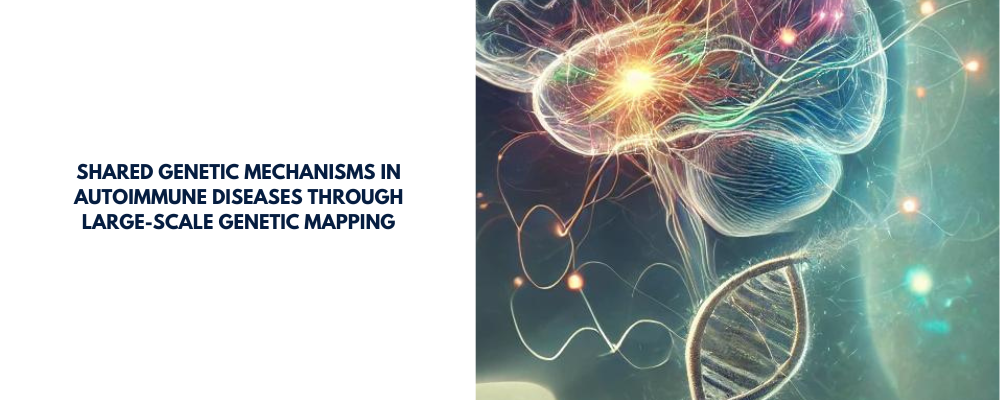Shared Genetic Mechanisms in Autoimmune Diseases through Large-Scale Genetic Mapping

Autoimmune and inflammatory diseases represent a heterogeneous group of disorders, characterized by the immune system’s attack on the body’s own tissues. The article "Genetic Mapping Across Autoimmune Diseases Reveals Shared Associations and Mechanisms," published in Nature Genetics, uncovers the intricate genetic associations shared between multiple autoimmune diseases, shedding light on the shared pathogenic mechanisms underlying these complex conditions.
A Polygenic Nature of Autoimmune Diseases
Autoimmune diseases are typically polygenic, meaning they arise from the combined effect of multiple genetic variants. These diseases, including celiac disease (CeD), inflammatory bowel disease (IBD), multiple sclerosis (MS), rheumatoid arthritis (RA), systemic lupus erythematosus (SLE), and type 1 diabetes (T1D), show substantial overlap in the genetic loci that harbor risk variants. However, distinguishing whether the same genetic allele contributes to multiple diseases or whether distinct alleles in the same region cause different diseases has been challenging due to limited resolution in genetic mapping.
This study analyzed data from 129,058 cases and controls across six autoimmune diseases, revealing that approximately 40% of the overlapping genetic associations between these diseases are driven by the same allele. This finding supports the hypothesis of shared genetic mechanisms driving multiple autoimmune diseases.
Fine-Mapping Reveals Shared Alleles
Using fine-mapping techniques, the authors were able to improve the resolution of genetic mapping by combining data from multiple diseases. This approach allowed the identification of more precise loci and increased the ability to detect shared expression quantitative trait loci (eQTLs), which regulate gene expression.
One key finding was the identification of shared effects at the C1orf106 locus, which was associated with CeD, IBD, and MS. Fine-mapping narrowed the association to a core set of eight variants, providing insights into the shared genetic mechanisms between these diseases. This suggests that C1orf106, previously implicated in epithelial junction stability, plays a critical role in these autoimmune conditions.
Shared Genetic Variants and Pleiotropy
Pleiotropy, where the same genetic variant influences multiple diseases, was found to be a major contributor to shared disease mechanisms. Of the 218 overlapping associations at 98 loci, 41% were shown to be driven by pleiotropic variants. These findings suggest that many autoimmune diseases share common molecular pathways that predispose individuals to multiple conditions.
Interestingly, certain alleles were found to have opposite effects on different diseases. For example, five loci showed opposing effects between MS and IBD, where a variant that increased the risk of MS decreased the risk of IBD. This is reminiscent of the differential responses to anti-TNF therapies, which improve symptoms in IBD but exacerbate MS.
Impact on Understanding Disease Pathogenesis
This study provides critical insights into the shared genetic architecture of autoimmune diseases, revealing that while there is widespread sharing of genetic risk variants, there is no evidence for a single global autoimmune mechanism. Instead, distinct genetic pathways may drive different autoimmune conditions even within the same genetic loci. The shared risk alleles often impact gene regulatory regions, particularly in immune cells such as T cells, monocytes, and neutrophils, highlighting the role of gene expression regulation in disease pathogenesis.
By increasing the fine-mapping resolution, the authors were able to link genetic risk variants to specific eQTLs in immune cells, providing a clearer picture of how genetic variants influence gene expression and, consequently, disease risk. For example, the RGS1 locus, associated with both MS and CeD, was shown to influence gene expression in T cells, suggesting that immune cell dysfunction plays a crucial role in these diseases.
Implications for Future Research and Therapy
Bioinformatics tools were employed to predict the functional impact of the EBI3 rs4740 and IL-12A rs568408 polymorphisms. The study suggests that the G-to-A substitution in EBI3 rs4740 may disrupt protein stability and influence the signaling pathways involved in immune regulation, including NF-κB and IFN-γ pathways. This disruption could explain the observed association between the EBI3 polymorphism and increased MS risk.
Implications for MS Treatment and Prognosis
The findings from this large-scale genetic mapping study have important implications for understanding the etiology of autoimmune diseases and developing targeted therapies. By identifying shared genetic mechanisms, researchers can prioritize key genetic loci for further functional studies and drug development. The discovery of shared eQTLs across multiple diseases also opens new avenues for therapeutic interventions aimed at modulating gene expression in specific immune cell types.
Additionally, this study highlights the importance of leveraging genetic data from multiple diseases to improve fine-mapping resolution and uncover shared disease mechanisms. As more genetic data becomes available, this approach can be applied to other complex diseases, potentially uncovering novel therapeutic targets and improving our understanding of disease mechanisms.
Limitations and Future Directions
While this study significantly advances our understanding of shared genetic mechanisms in autoimmune diseases, there are limitations to the approach. The study focused primarily on European-ancestry populations, and further research is needed to determine whether these findings apply to other populations. Moreover, while fine-mapping increased the resolution of genetic associations, the resolution was still limited in some cases, and additional studies using whole-genome sequencing may be needed to fully resolve the genetic architecture of these diseases.
Future studies should also explore the functional consequences of the identified shared genetic variants, particularly in the context of immune cell function and tissue-specific gene regulation. Understanding how these variants influence disease development at the molecular level will be crucial for developing precision medicine approaches to treat autoimmune diseases.
Conclusion
The study by Lincoln et al. provides compelling evidence of shared genetic mechanisms across multiple autoimmune diseases, highlighting the complex interplay of genetic variants that drive disease risk. By improving fine-mapping resolution and identifying shared eQTLs, this research paves the way for a deeper understanding of autoimmune disease pathogenesis and the development of more effective therapies.
Reference:
Lincoln, M.R., Connally, N., Axisa, PP. et al. Genetic mapping across autoimmune diseases reveals shared associations and mechanisms. Nat Genet 56, 838–845 (2024).
